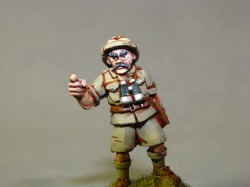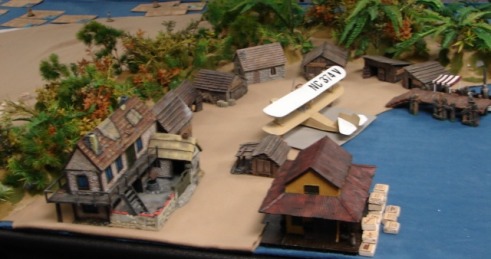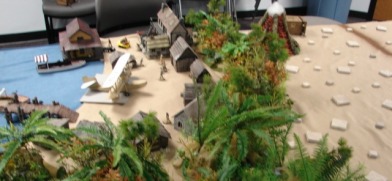Paynes Landing
Welcome to Payne's Landing

Payne's landing is a showcase for our pulp adventures. We want to inspire and also to share some of the elements which characterize our gaming experience.
I would like to thank all that contribute these thrilling adventures. Specifically I would like to thank my brother Dave Brewer who has contributed an enormous amount of props to this venture. Secondly I would like to thank my particular friend Joe Muise for his unfailing support of these games with his many excellent buildings, figures and ideas. Also deserving of special mention is the photographic support of one of my most avid participant Andy Ortig III. A successful game is never the product of any one person, but relies on each participant who's enthusiasm inspires to still greater efforts.
There are two other individuals that deserve special attention. Bill Daniels of the Denver gaming community for inspiring me through his "Keeping up with the Jones's" convention format pulp adventure. For the inspiration to actually produce my first pulp game. Also deserving of special attention is Richard of ".45 Adventures" for not only the great set of rules that form the core of our adventures but also the great introduction to his game at "Cold Wars 2008."
I would like to thank all that contribute these thrilling adventures. Specifically I would like to thank my brother Dave Brewer who has contributed an enormous amount of props to this venture. Secondly I would like to thank my particular friend Joe Muise for his unfailing support of these games with his many excellent buildings, figures and ideas. Also deserving of special mention is the photographic support of one of my most avid participant Andy Ortig III. A successful game is never the product of any one person, but relies on each participant who's enthusiasm inspires to still greater efforts.
There are two other individuals that deserve special attention. Bill Daniels of the Denver gaming community for inspiring me through his "Keeping up with the Jones's" convention format pulp adventure. For the inspiration to actually produce my first pulp game. Also deserving of special attention is Richard of ".45 Adventures" for not only the great set of rules that form the core of our adventures but also the great introduction to his game at "Cold Wars 2008."
Wrath of the Mountain Godess - (Set up)

Here's a shot of the set up for the adventure "Wrath of the Mountain Goddess". This south pacific Island adventure was based on the excellent material available as a PDF Download by Peter Schweighofer of Griffon Publishing Studio. The Download titled "Heroes of Rura-Tonga - Pulp adventures in the South Pacific" are very well written and adaptable to any rules format. In my scenarios I like to incorporate a little logistics. I generally start the players with a small budget which allows them to pay recruits, purchase equipment, or rent transport. The transport might include pack mules, dugout canoe guides, steam launch captains, or even a private charter biplane.
Start of "Wrath of the Mountain Goddess

Here we have an initial layout. You can see on the right the travertine tiles that I use for both encounter as well as Terrain features as well. By using tiles of two different sizes players are given a clue to their nature. The large 2" (5 cm) tiles represent terrain features or major encounters, like dinosaurs. They represent things that can be seen from the air. The small 1" tiles represent finds and small hazards which must be discovered by getting close to them, like quicksand.
I let the players randomly distribute the tokens in the set up phase. This accomplishes several things: First it involves the players in the set up. Secondly it creates for me a sense of uncertainty, as the random placement creates dynamics that I would never have envisioned. Thirdly it distances the GM from the encounters. We all have seen the adversarial relationship that can develop in games between the players and the GM. Sometimes they feel picked on, at other times they feel you are favoring a particular player. By allowing them to place the elements they gain a sense of control or perhaps more importantly remove a sense of control from the GM. I know what you are thinking! How do you steer the action?
There are ways, and I will show you how.
I let the players randomly distribute the tokens in the set up phase. This accomplishes several things: First it involves the players in the set up. Secondly it creates for me a sense of uncertainty, as the random placement creates dynamics that I would never have envisioned. Thirdly it distances the GM from the encounters. We all have seen the adversarial relationship that can develop in games between the players and the GM. Sometimes they feel picked on, at other times they feel you are favoring a particular player. By allowing them to place the elements they gain a sense of control or perhaps more importantly remove a sense of control from the GM. I know what you are thinking! How do you steer the action?
There are ways, and I will show you how.
